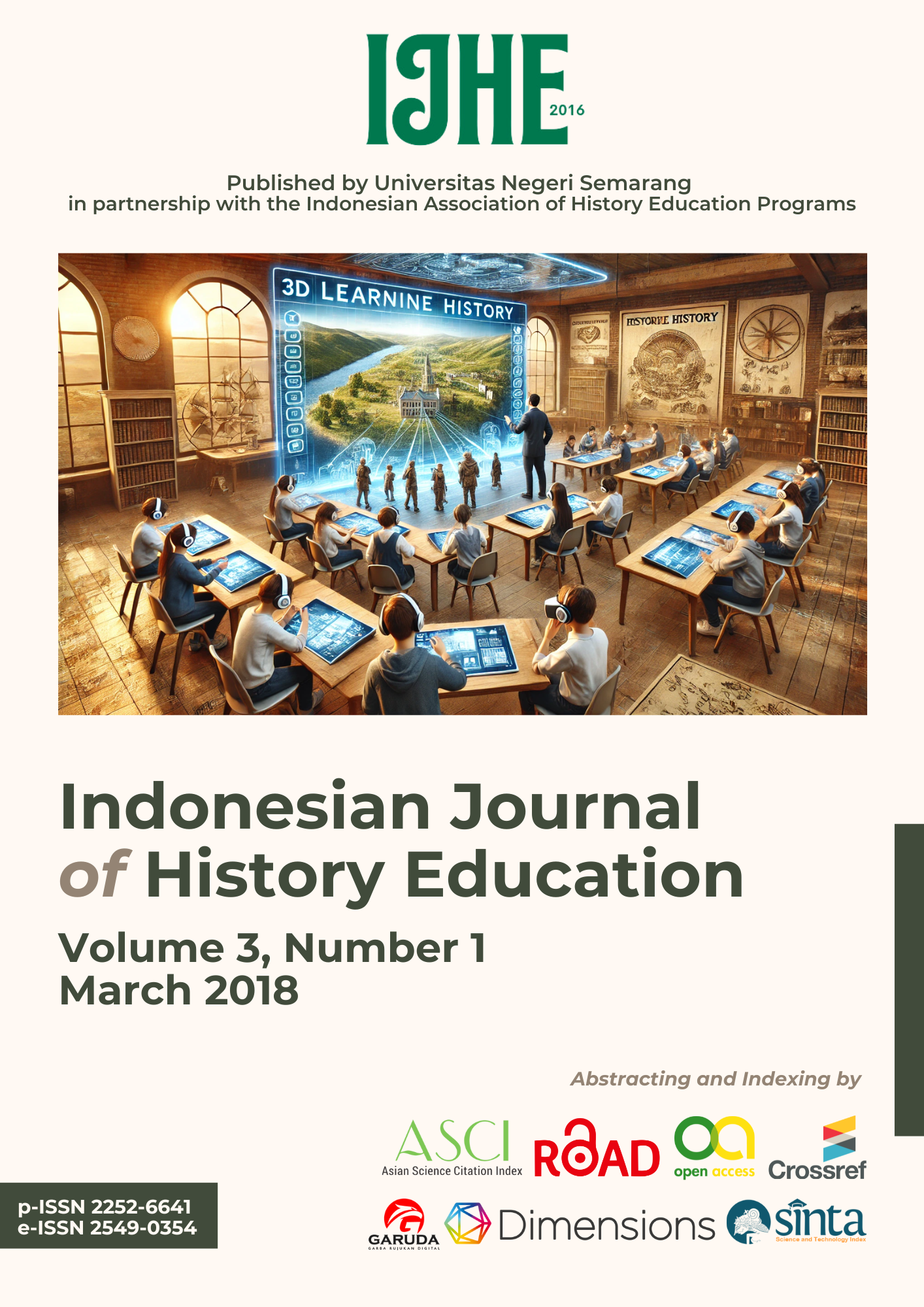Improving Student Activities and Learning Outcomes in History Subjects through the Cooperative Integrated Reading and Composition Learning Model
Abstract
Learning is successful when students can comprehend what has been received. Using learning models not only helps teachers teach but also aids students in understanding the material being studied in greater depth. When effective learning models are employed, they cater to various learning styles, ensuring that students grasp complex concepts more quickly. Results of preliminary observations in High School 2 Magelang provided insightful data, indicating that students of class XI Social 2 still require significant assistance with their activity levels and learning outcomes, particularly in history subjects. The data revealed that the mastery learning level of class XI Social 2 at High School 2 Magelang before the implementation of new strategies was only at 32.5%. This statistic highlights that students' engagement and mastery of the subject matter were alarmingly low, signaling a need for an intervention. This study aimed to determine whether applying the Cooperative Integrated Reading and Composition (CIRC) learning model could increase students' activity and learning outcomes in history courses for class XI Social 2 at High School 2 Magelang during the 2013/2014 school year. The CIRC model promotes cooperative learning, where students work together in small groups, enhancing their reading comprehension and writing skills through integrated activities. By fostering a collaborative learning environment, the CIRC model aims to make learning more interactive and engaging, which can lead to improved academic performance and higher levels of student participation. This research is significant as it explores the potential of innovative teaching methods to address educational challenges and improve student outcomes in a real-world setting.
References
Arikunto, S. (2009a). Dasar-dasar evaluasi pendidikan. Rineka Cipta.
Arikunto, S. (2009b). Penelitian tindakan kelas. Rineka Cipta.
Arikunto, S. (2010). Prosedur penelitian suatu pendekatan praktik. Rineka Cipta.
Handayani, T. (2011). Membangun komunikasi efektif untuk meningkatkan kualitas dalam proses belajar mengajar. Ta'dib: Jurnal Pendidikan Islam, 16(02), 273-302.
Hanifah, N. (2014). Memahami penelitian tindakan kelas: Teori dan aplikasinya. UPI Press.
Hanum, F. (2008). Penelitian tindakan kelas. Diklat Penelitian Tindakan Kelas (PTK) Lanjut Tingkat Nasional Bagi Guru Pamong Belajar, 9-10 Agustus 2008, 1-12.
Hamalik, O. (2003). Proses belajar mengajar. Bumi Aksara.
Hidayat, U. S. (2016). Model-model pembelajaran efektif. Bina Mulia Publishing.
Huriaty, D. (2010). Mengembangkan komunikasi yang efektif dalam pembelajaran di kelas. Al-Bidayah: Jurnal Pendidikan Dasar Islam, 2(1).
Inah, E. N. (2013). Peranan komunikasi dalam pendidikan. Al-Ta'dib: Jurnal Kajian Ilmu Kependidikan, 6(1), 176-188.
Kochhar, S. K. (2008). Teaching of history: Pembelajaran sejarah. PT Grasindo.
Komariah, A. (2009). Melaksanakan supervisi akademis melalui penelitian tindakan sekolah (School Action Research). Jurnal Administrasi Pendidikan, 6(2).
Lubis, A. (2012). Pengaruh model pembelajaran kooperatif tipe STAD terhadap hasil belajar fisika siswa pada materi pokok gerak lurus di kelas X SMA Swasta UISU Medan. Jurnal Pendidikan Fisika Unimed, 1(1), 27-32.
Mahendra, I. W. E., & Eka, W. (2016). Meningkatkan kualitas pembelajaran melalui penelitian tindakan kelas (PTK). Tersedia: http://repo.ikippgribali.ac.id/eprint/223/ [14 Januari 2021].
Mulyasa, E. (2009). Menjadi guru profesional: Menciptakan pembelajaran kreatif dan menyenangkan. PT Remaja Rosdakarya.
Mulyatiningsih, E. (2015). Metode penelitian tindakan kelas. Modul Pelatihan Pendidikan Profesi Guru: Fakultas Teknik, Universitas Negeri Yogyakarta. Universitas Negeri Yogyakarta.
Ni’mah, Z. A. (2017). Urgensi penelitian tindakan kelas bagi peningkatan profesionalitas guru antara cita dan fakta. Realita: Jurnal Penelitian dan Kebudayaan Islam, 15(2).
Pontoh, W. P. (2013). Peranan komunikasi interpersonal guru dalam meningkatkan pengetahuan anak. Acta Diurna Komunikasi, 2(1).
Prastowo, A. (2012). Panduan kreatif membuat bahan ajar inovatif. Diva Press.
Putra, N. (2011). Research & development: Penelitian dan pengembangan: Suatu pengantar. Rajawali Press.
Sanjaya, H. W. (2016). Media komunikasi pembelajaran. Prenada Media.
Slameto. (2010). Belajar dan faktor yang mempengaruhinya. Rineka Cipta.
Sugara, B. (2015). Hubungan komunikasi (verbal dan non-verbal) guru dalam proses belajar mengajar dengan hasil belajar biologi pada materi sel unit terkecil kehidupan dan bioproses di SMA Negeri 16 Medan tahun pembelajaran 2015/2016 (Doctoral dissertation, UNIMED).
Suprijono, A. (2009). Cooperative learning teori dan aplikasi PAIKEM. Pustaka Pelajar.
Tamburaka, R. E. (2002). Pengantar ilmu sejarah, teori filsafat sejarah, sejarah filsafat, dan IPTEK. Rineka Cipta.
Trianto. (2007). Model-model pembelajaran inovatif berorientasi konstruktivistik. Prestasi Pustaka.
Widja, I. G. (1989). Dasar-dasar pengembangan strategi serta metode pengajaran sejarah. DIKTI.
Copyright (c) 2018 Aprilia Nur Fitriana

This work is licensed under a Creative Commons Attribution 4.0 International License.
Copyright Notice
An author who publishes in the Jurnal Indonesian Journal of History Education agrees to the following terms:
- Author retains the copyright and grants the journal the right of first publication of the work simultaneously licensed under the Creative Commons Attribution-ShareAlike 4.0 License that allows others to share the work with an acknowledgement of the work's authorship and initial publication in this journal
- Author is able to enter into separate, additional contractual arrangements for the non-exclusive distribution of the journal's published version of the work (e.g., post it to an institutional repository or publish it in a book) with the acknowledgement of its initial publication in this journal.
- Author is permitted and encouraged to post his/her work online (e.g., in institutional repositories or on their website) prior to and during the submission process, as it can lead to productive exchanges, as well as earlier and greater citation of the published work (See The Effect of Open Access).
Read more about the Creative Commons Attribution-ShareAlike 4.0 Licence here: https://creativecommons.org/licenses/by-sa/4.0/.




